Unsolved Chess Mysteries (17)
By Edward Winter
Chess scandals are common enough and tend to concern alleged cheating by players
and/or maladministration by officials. The affairs may even briefly interest
the mainstream press, but few eyelids are batted, even by insiders, over cases
of theft or other malpractice regarding the game’s literature. As noted
in the first of these Unsolved Chess Mysteries articles, a Spanish publisher
brought out a book whose author was slyly named as ‘Garry Kaspartov’,
but who minded much? (Would there, though, be similar indifference if a duplicitous
English-language publisher issued a chess book billed as being by ‘Bobby
Fisher’?) As shown in our feature article on Copying,
all sorts of ‘chess writers’ have freely passed off the output of
others as their own, but few cases, if any, have resulted in the deserved public
outcry.
A striking example is the Coles affair. In May 2002 Rick Kennedy (Columbus,
OH, USA) mentioned at the Chess Café Bulletin Board that Coles Publishing Company
Inc. (Canada) had, in 1976, brought out a book entitled Chess Strategy
by Frank Eagan which was, in fact, a verbatim reproduction of Capablanca’s
Chess Fundamentals. That was, strange to say, our first knowledge of
the mysterious Frank Eagan, and we hastened to procure a copy. It turned out
that, apart from the title page, the entire contents were identical to the crown
octavo edition of Chess Fundamentals (i.e. the 184-page version first
produced by G. Bell in 1951).

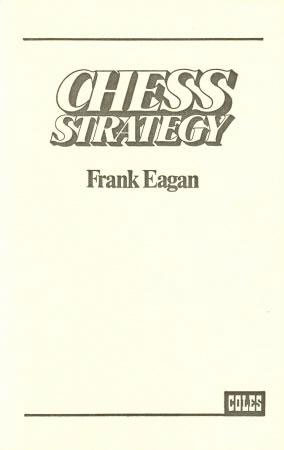
The imprint page (‘Copyright 1976 and published by Coles Publishing Company
Limited Toronto – Canada’) also had, in tiny letters, ‘Originally
published by G. Bell & Sons Ltd. London England’, but neither Capablanca’s
name nor the title Chess Fundamentals was given anywhere.

The publishers of this outrage are/were an internationally-known company, the
producers of the ‘Coles Notes’ series of booklets of literary criticism.
How did such fraud occur and, apparently, remain unnoticed (bearing in mind,
incidentally, that in 1976 the company G. Bell was still producing chess books)?
And who was Frank Eagan? His name vanished in 1980 when Coles reissued Chess
Strategy and belatedly put Capablanca’s name on the title page.
Another 1976 chess book published by Coles, ‘Play Winning Chess
by Brian Drew’ soon came to hand.

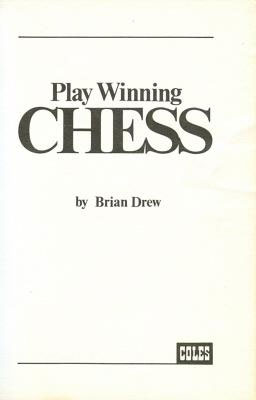
We at once recognized the contents as identical to Chess in an Hour
by F.J. Marshall and I. Chernev (published by Arco, New York in 1968 and 1975).
‘Identical’, that is, with one significant exception. Page 47 of
the earlier volume had the following note:
‘The new material found in pages 48 through 93 was compiled and prepared
expressly for this newly revised edition by Irving Chernev.’
That was deleted from the Coles edition and, indeed, there was no mention
of either Chernev or Marshall as the authors. It may be recalled here that Marshall’s
original book was published in 1937 and that at the time Coles introduced ‘Brian
Drew’ to the chess world Irving Chernev was still alive.
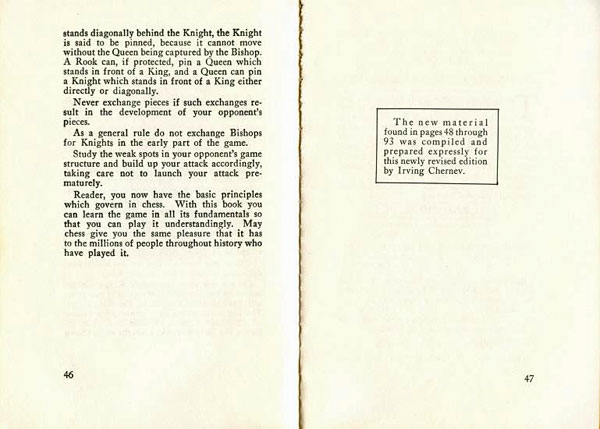
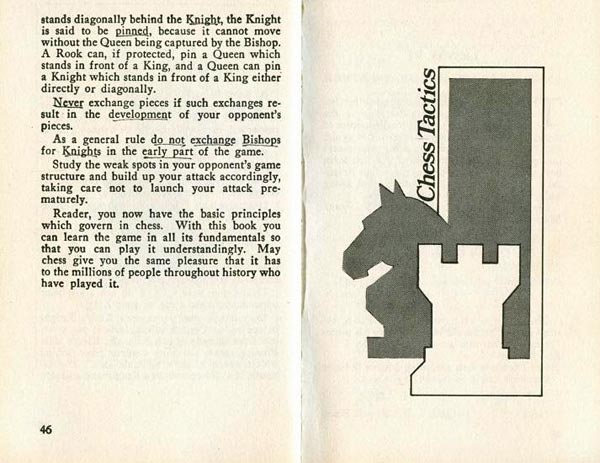
Also in 1976 Coles brought out ‘Two Weeks To Winning Chess by
Thomas E. Kean’:
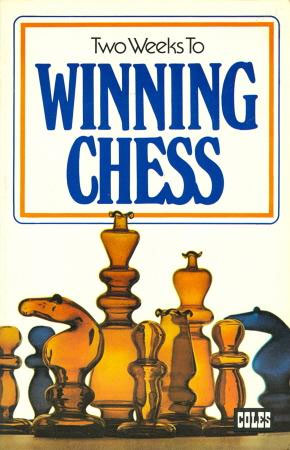
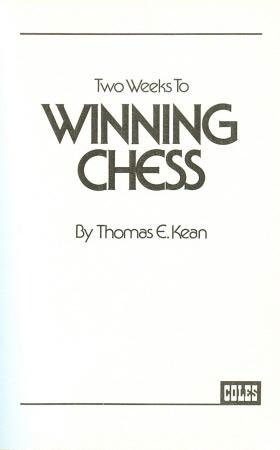
The title repeated an old one of Reinfeld’s, but the contents were, from
start to finish, a direct reproduction of the well-known introductory book Chess
by R.F. Green. Below are the opening pages of the Green book (1938 edition)
and the Kean one (1976). The concluding words (‘Free use has, necessarily,
been made of standard works on the game’) take on a whole new meaning
in the light of Coles’ practices.
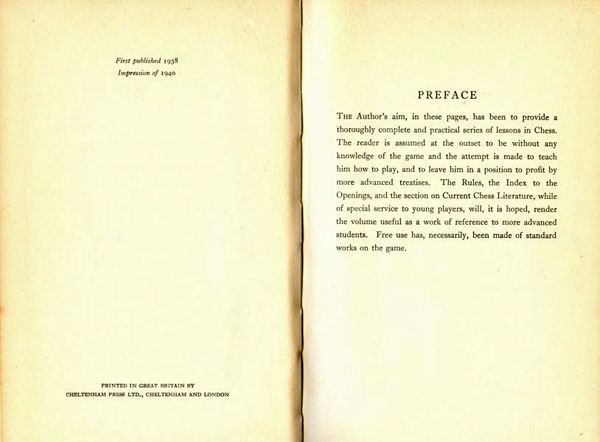

Not that Coles always changed, or invented, authors’ names. Its 1979
volume Chess Problems for Beginner or Expert by John M. Rice had, in
small letters on the copyright page (yes, Coles books always had one of those…),
the following statement: ‘Originally published by Faber & Faber’.
That is so. The text, all 349 pages of it, was identical to John Rice’s
1970 work An ABC of Chess Problems.
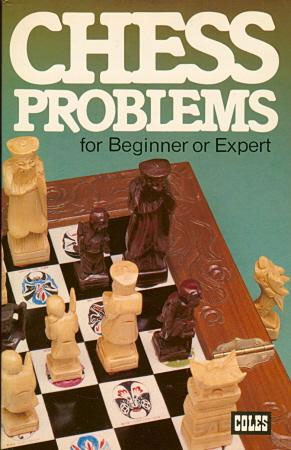

In 2002 we asked Mr Rice whether he had authorized the Coles edition of his
book, and he replied that he was not even aware of it.
Yet another example, from 1980, was ‘Teach yourself Chess by John
Love’. That turned out to be a reprint of Love’s book Chess:
A New Introduction (published by Bell in 1967).

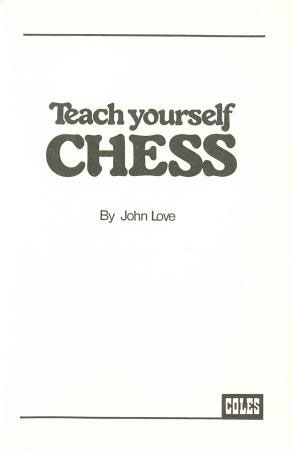
We asked Mr Love whether he was aware of the later edition, and he replied:
‘No, I knew nothing about this Coles publication. As you can imagine,
I was more than a little surprised by the contents, not least by the thought
that I’d ever written anything worth stealing.’
The Coles affair was discussed in C.N.s 2657, 2689, 2711, 2736 and 2754. Can
anything further be discovered about the company’s behaviour?
Now, from Canada to India.


As shown in C.N. 2750 (see pages 335-337 of A Chess Omnibus), the book
Chess (Basics, Laws and Terms) by B.K. Chaturvedi (Chandigarh, 2001)
copied extensively from Chess Made Easy by C.J.S. Purdy and G. Koshnitsky.
In C.N. 4683, however, we offered a rebondissement: was it possible that
the (dire) Indian volume was itself subsequently the victim of plagiarism? Below,
on the left, is a passage from page 6 of the Chaturvedi book, alongside the
text on page 8 of A Guide To Chess ‘Edited and Revised by Philip
Robar’ (New Delhi, 2002):
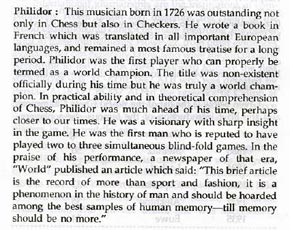
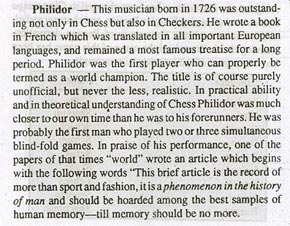
The next paragraph in both books (pages 7 and 9 respectively) is a particularly
bumpy read:
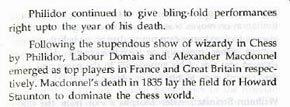

Among other examples of ‘similarities’ are the books’ concluding
glossaries, but is it a plain case of plagiarism by the Robar volume? Matters
are far from simple. For instance, the imprint page of the Robar book stated,
however implausibly, ‘XIVth Edition 2002’; if there have truly been
13 previous editions of A Guide To Chess, most, if not all, of them would
pre-date the 2001 Chaturvedi book. But who is Philip Robar? And what exactly
was ‘edited and revised’ by him for the Guide?
A further consideration is that his name was not on the cover but only on
the title page:
An additional mystery concerns the book’s spine: it named the author
as ‘Dr C.P. Mithal’.
We returned to the subject in C.N. 4717,
pointing out that the publishing company’s website showed a line-up of
chess volumes whose authorship was ascribed to that same mysterious Philip Robar.
By way of example, we briefly examined one of them, Techniques of End Game
in Chess (New Delhi, 2002):
Different typefaces and notations were used in the book, and of necessity because
90 pages were lifted, unascribed, from Chess endings for the practical player
by L. Pachman (London, 1983) and about 100 pages were stolen from Practical
Chess Endgames by D. Hooper (London, 1968).
Sample pages are shown below:
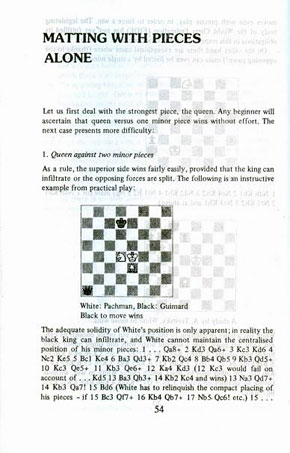
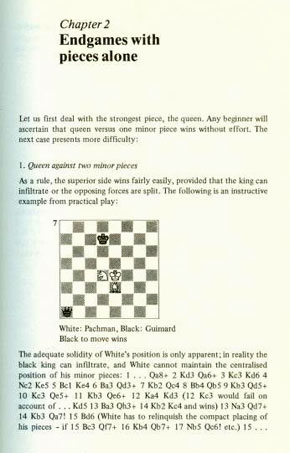
Robar (left) and Pachman


Robar (left) and Hooper
It will be noted that the Robar book amended the chapter endings, with a misspelling
both times. Everything in Techniques of End Game in Chess from page 49
to the end (page 240, which chopped off Pachman’s analysis in mid-flow)
was by either Pachman or Hooper.
Not surprisingly, the other chess productions of Pankaj Books were also put
together, without attribution, from previous writers’ work. As in the
case of Coles, more details about the company’s conduct will be welcome.
Submit information
or suggestions on chess mysteries
 Edward
Winter is the editor of Chess
Notes, which was founded in January 1982 as "a forum for aficionados
to discuss all matters relating to the Royal Pastime". Since then around
5,000 items have been published, and the series has resulted in four books by
Winter: Chess
Explorations (1996), Kings,
Commoners and Knaves (1999), A
Chess Omnibus (2003) and Chess
Facts and Fables (2006). He is also the author of a monograph
on Capablanca (1989).
Edward
Winter is the editor of Chess
Notes, which was founded in January 1982 as "a forum for aficionados
to discuss all matters relating to the Royal Pastime". Since then around
5,000 items have been published, and the series has resulted in four books by
Winter: Chess
Explorations (1996), Kings,
Commoners and Knaves (1999), A
Chess Omnibus (2003) and Chess
Facts and Fables (2006). He is also the author of a monograph
on Capablanca (1989).
Chess Notes is well known for its historical research, and anyone browsing
in its archives
will find a wealth of unknown games, accounts of historical mysteries, quotes
and quips, and other material of every kind imaginable. Correspondents from
around the world contribute items, and they include not only "ordinary
readers" but also some eminent historians – and, indeed, some eminent
masters. Chess Notes is located at the Chess
History Center.
Articles by Edward Winter
-
Edward Winter presents: Unsolved Chess Mysteries (1)
14.02.2007 – Since Chess
Notes began, over 25 years ago, hundreds of mysteries and puzzles have
been discussed, with many of them being settled satisfactorily, often thanks
to readers. Some matters, though, have remained stubbornly unsolvable –
at least so far – and a selection of these is presented here. Readers are
invited to join
in the hunt for clues.
-
Edward Winter presents: Unsolved Chess Mysteries (2)
12.03.2007 – We bring you a further selection
of intriguing chess mysteries from Chess
Notes, including the origins of the Marshall Gambit, a game ascribed
to both Steinitz and Pillsbury and the bizarre affair of an alleged blunder
by Capablanca in Chess Fundamentals. Once again our readers are invited
to join the hunt
for clues.
-
Edward Winter presents: Unsolved Chess Mysteries (3)
27.03.2007 – Recently-discovered photographs
from one of Alekhine’s last tournaments, in Spain in 1945, are proving baffling.
Do they show that a 15-move brilliancy commonly attributed to Alekhine is
spurious? And do they disprove claims that another of his opponents was
an 11-year-old boy? Chess
Notes investigates, and once again our readers are invited to join
in the hunt for clues.
-
Edward Winter presents: Unsolved Chess Mysteries (4)
10.04.2007 – What would have happened if the
score of the 1927 Capablanca v Alekhine match had reached 5-5? Would the
contest have been declared drawn? The affair has been examined in depth
in Chess Notes.
Here chess historian Edward Winter sifts and summarizes the key evidence.
There is also the strange case of a fake photograph of the two masters.
Join
the investigation.
-
Edward Winter presents: Unsolved Chess Mysteries (5)
30.04.2007 – We bring you a further selection
of mysteries from Edward Winter’s Chess
Notes, including an alleged game by Stalin, some unexplained words attributed
to Morphy, a chess magazine of which no copy can be found, a US champion
whose complete name is uncertain, and another champion who has vanished
without trace. Our readers are invited to join
in the hunt for clues.
-
Edward Winter presents: Unsolved Chess Mysteries (6)
19.05.2007 – A further miscellany of mysteries
from Chess Notes is presented
by the chess historian Edward Winter. They include an alleged tournament
game in which Black was mated at move three, the unclear circumstances of
a master’s suicide, a chess figure who was apparently unaware of his year
of birth, the book allegedly found beside Alekhine’s body in 1946, and the
chess notes of the poet Rupert Brooke. Join
in the hunt for clues.
-
Edward Winter presents: Unsolved Chess Mysteries (7)
02.06.2007 – The chess historian Edward Winter
presents another selection of mysteries from Chess Notes. They include an
alleged game by Albert Einstein, the origin of the Trompowsky Opening, the
termination of the 1984-85 world championship match, and the Marshall brilliancy
which supposedly prompted a shower of gold coins. Readers are invited to
join in the hunt
for clues.
-
Edward Winter presents: Unsolved Chess Mysteries (8)
In this further selection from Chess
Notes historian Edward Winter examines some unauthenticated quotes,
the Breyer Defence to the Ruy López, the origins of the Dragon Variation,
the contradictory evidence about a nineteenth century brilliancy, and the
alleged 1,000-board exhibition by an unknown player. Can our readers help
to solve these new
chess mysteries?
-
Edward Winter presents: Unsolved Chess Mysteries (9)
Why did Reuben Fine withdraw from the 1948 world championship?
Did Capablanca lose an 11-move game to Mary Bain? Was Staunton criticized
by Morphy for playing ‘some devilish bad games’? Did Alekhine
play Najdorf blindfold? Was Tartakower a parachutist? These and other mysteries
from Chess
Notes are discussed by Edward Winter. Readers are invited to join in
the hunt
for clues.
-
Edward Winter presents: Unsolved Chess Mysteries (10)
15.07.2007 – Did Tsar Nicholas II award the ‘grandmaster’
title to the five finalists of St Petersburg, 1914? What connection exists
between the Morphy family and Murphy beer? Can the full score of one of
Pillsbury’s most famous brilliancies be found? Did a 1940s game repeat
a position composed 1,000 years previously? Edward Winter, the Editor of
Chess
Notes, presents new
mysteries for us to solve.
-
Edward Winter presents: Unsolved Chess Mysteries (11)
01.08.2007 – Did Alekhine attempt suicide in 1922? Why is
1 b4 often called the Hunt Opening? What are the origins of the chess proverb
about the gnat and the elephant? Who was the unidentified figure wrongly
labelled Capablanca by a chess magazine? Does Gone with the Wind
include music composed by a chess theoretician? These and other mysteries
from Chess Notes
are discussed by the historian Edward Winter. Readers are invited to join
the hunt for clues.
-
Edward Winter presents: Unsolved Chess Mysteries (12)
12.08.2007 – This new selection from Chess
Notes focuses on José Raúl Capablanca (1888-1942). The chess historian
Edward Winter, who wrote a book about the Cuban genius in the 1980s (published
by McFarland), discusses a miscellany of unresolved matters about him, including
games, quotes, stories and photographs. Readers are invited to join
in the hunt for clues.
-
Edward Winter presents: Unsolved Chess Mysteries (13)
26.08.2007 – In a 1937 game did Alekhine play two moves in succession?
Can the full score of a Nimzowitsch brilliancy be found? Who was Colonel
Moreau? Why was it claimed that Morphy killed himself? Who were the first
masters to be filmed? What happened in the famous Ed. Lasker v Thomas game?
Is a portrait of the young Philidor genuine? From Chess
Notes comes a new selection of mysteries
to solve.
-
Edward Winter presents: Unsolved Chess Mysteries (14)
The latest selection from Chess
Notes consists of ten positions, including fragments from games ascribed
to Capablanca and Nimzowitsch. Was an alleged Bernstein victory a composition?
What is known about a position in which Black resigned despite having an
immediate win? Can more be discovered about the classic Fahrni pawn ending?
Readers are invited to join
in the hunt for clues.
-
Edward Winter presents: Unsolved Chess Mysteries (15)
Chess books repackaged as camouflage in Nazi Germany. Numerous contradictions
regarding a four-move game. The chess encyclopaedia that never was. Quotes
strangely attributed to Spielmann and Capablanca. These and other mysteries
are discussed in the latest selection from Chess
Notes. Readers are invited to join
in the hunt for clues.
-
Edward Winter presents: Unsolved Chess Mysteries (16)
Did Lasker invent a tank? Why did Mieses complain to FIDE about Bogoljubow?
What merchandising carried Flohr’s name? Who coined the term ‘grandmaster
draw’? What did Hans Frank write about Alekhine? Did Tom Thumb play
chess? These are just some of the questions discussed in the latest selection
from Chess Notes.
Readers are invited to join
in the hunt for clues.
-
Edward Winter presents: Unsolved Chess Mysteries (17)
This further selection from Chess
Notes examines some gross examples of fraud and plagiarism in chess
literature. A number of books, for instance, have been published in Canada
and India under the names of Brian Drew, Frank Eagan, Thomas E. Kean and
Philip Robar, but did any of those individuals even exist? Readers are invited
to join
in the hunt for clues.








































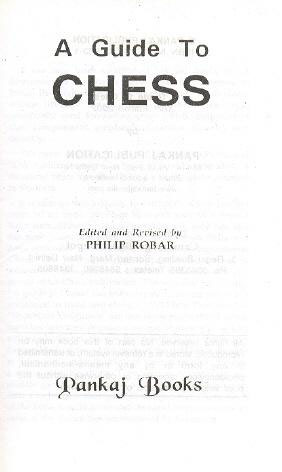





 Edward
Winter is the editor of
Edward
Winter is the editor of 




